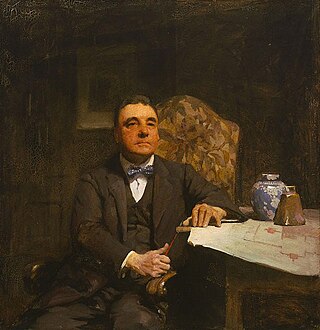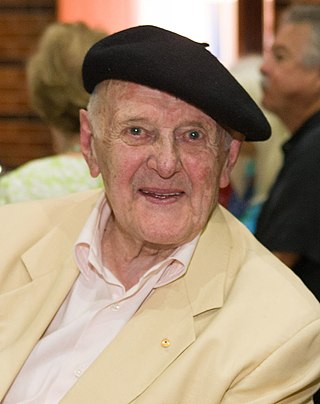Related Research Articles

Anzac Day is a national day of remembrance in Australia, New Zealand and Tonga that broadly commemorates all Australians and New Zealanders "who served and died in all wars, conflicts, and peacekeeping operations" and "the contribution and suffering of all those who have served". Observed on 25 April each year, Anzac Day was originally devised to honour the members of the Australian and New Zealand Army Corps (ANZAC) who served in the Gallipoli campaign, their first engagement in the First World War (1914–1918).

The Archibald Prize is an Australian portraiture art prize for painting, generally seen as the most prestigious portrait prize in Australia. It was first awarded in 1921 after the receipt of a bequest from J. F. Archibald, the editor of The Bulletin who died in 1919. It is administered by the trustees of the Art Gallery of New South Wales and awarded for "the best portrait, preferentially of some man or woman distinguished in Art, Letters, Science or Politics, painted by an artist resident in Australia during the twelve months preceding the date fixed by the trustees for sending in the pictures". The Archibald Prize has been awarded annually since 1921 and since July 2015 the prize has been AU$100,000.
The Miles Franklin Literary Award is an annual literary prize awarded to "a novel which is of the highest literary merit and presents Australian life in any of its phases". The award was set up according to the will of Miles Franklin (1879–1954), who is best known for writing the Australian classic My Brilliant Career (1901). She bequeathed her estate to fund this award. As of 2016, the award is valued at A$60,000.
Jana Bohumila Wendt is an Australian Gold Logie award-winning television journalist, reporter and writer.

John Henry Olsen AO OBE was an Australian artist and winner of the 2005 Archibald Prize. Olsen's primary subject of work was landscape.

Wendy Sharpe is an Australian artist who lives and works in Sydney and Paris. She has had many solo exhibitions nationally and internationally, been awarded many national awards and artist residencies for her work, and was an official Australian war artist to East Timor in 1999–2000.

Robert Lyall "Alfie" Hannaford is an Australian realist artist notable for his drawings, paintings, portraits and sculptures. He is a great-great-great-grandson of Susannah Hannaford.

Ben Quilty is an Australian artist and social commentator, who has won a series of painting prizes: the 2014 Prudential Eye Award, 2011 Archibald Prize, and 2009 Doug Moran National Portrait Prize. He has been described as one of Australia's most famous living artists.

The Sculpture by the Sea exhibition in Sydney and Perth is Australia's largest annual outdoor sculpture exhibition. This exhibition was initiated in 1997, at Bondi Beach and it featured sculptures by both Australian and overseas artists. In 2005, a companion event was established at Cottesloe Beach in Western Australia featuring over 70 artists. In 2009 it was announced that Aarhus in Denmark would host the first Sculpture by the Sea exhibition outside of Australia.
Leslie Allen Carlyon was an Australian writer and newspaper editor.

William Barton is an Aboriginal Australian composer and multi-instrumentalist, known for his and didgeridoo (yidaki) playing, particularly with classical orchestras.
The New South Wales Premier's Literary Awards, also known as the NSW Premier's Literary Awards, were first awarded in 1979. They are among the richest literary awards in Australia. Notable prizes include the Christina Stead Prize for Fiction, the Kenneth Slessor Prize for Poetry, and the Douglas Stewart Prize for Non-Fiction.
Imants Tillers, is an Australian artist, curator and writer. He lives and works in Cooma, New South Wales.

Shen Jiawei is a Chinese-Australian painter. He is a winner of the 2006 Sir John Sulman Prize.

Ellen José (1951 – 2 June 2017) was an Australian Indigenous artist, photographer and anarchist. She was a Torres Strait Islander descendant from Murray, Darnley and Horn Islands who lived in Melbourne with husband and fellow anarchist Joseph Toscano.
The following lists events that happened during 2011 in Australia.
The Glover Prize is an Australian annual art prize awarded for paintings of the landscape of Tasmania The prize was inaugurated in 2004 by the John Glover Society, based in Evandale, Tasmania, in honour of the work of British-born landscape painter John Glover, who lived and painted in the area from 1832 until his death in 1849. The current prize amount of A$ 50,000 is the highest for landscape painting in Australia. The 2012 award was controversial: the winning picture included a depiction of convicted Port Arthur massacre spree killer Martin Bryant in the landscape of Port Arthur.

Steve Lopes is an Australian figurative artist. He has exhibited in 40 solo shows across Australia, London and Hong Kong. His work is collected in the National Gallery of Australia, Federal Parliament House Art Collection Canberra, State Library of NSW, Bundanon Collection, Gallipoli Memorial Club, Time Warner Collection New York, Rolls-Royce London and public galleries and private collections around the world.
Sally Robinson is an English-born Australian artist. She has had a long career as a portrait artist and designer, painter and printmaker, teacher and lecturer. Her work is represented in private and public collections around Australia.
References
- 1 2 3 "$20,000 Gallipoli Art Prize encourages entrants to think outside the square". ArtsHub Australia. 24 January 2022. Retrieved 26 May 2022.
- 1 2 "About". Gallipoli Art Prize. 16 April 2021. Retrieved 26 May 2022.
- ↑ Bibby, Paul (24 April 2007). "Young and afraid: capturing humanity behind heroism". Sydney Morning Herald.
- 1 2 3 4 "Past Winners". Gallipoli Art Prize. Retrieved 13 September 2024.
- ↑ Schwartzkoff, Louise (24 April 2008). "From a son to a father, a feat of love". The Age. Retrieved 13 September 2024.
- ↑ curated by Gavin Wilson (2010). Surface Tension: the art of Euan Macleod 1991 - 2009 (PDF). A Tweed River Art Gallery touring exhibition: Western Plains Cultural Centre.
- ↑ "Wilson's Sacrifice wins Gallipoli prize". ABC News. 20 April 2011. Retrieved 13 September 2024.
- ↑ "Rusty artwork wins Gallipoli Art Prize". ABC News. 23 April 2012. Retrieved 13 September 2024.
- ↑ Taylor, Andrew (23 April 2013). "A painted pointer claims Gallipoli". The Sydney Morning Herald. Retrieved 13 September 2024.
- ↑ "Idris Murphy Wins 2014 Gallipoli Art Prize". Artist Profile. 1 May 2014. Retrieved 13 September 2024.
- ↑ Kembrey, Melanie (22 April 2015). "Sally Robinson's 'Boy Soldiers' wins Gallipoli Art Prize 2015". The Sydney Morning Herald. Retrieved 13 September 2024.
- ↑ "Chinese-Australian artist Jiawei Shen wins Gallipoli Art Prize". ABC News. 20 April 2016. Retrieved 13 September 2024.
- ↑ "Sydney-based artist wins Gallipoli Art Prize with painting of 'sacred burial ground'". ABC News. 19 April 2017. Retrieved 13 September 2024.
- 1 2 3 4 "Past Winners". Gallipoli Art Prize. Retrieved 13 September 2024.
- ↑ "A sword used in World War I features in award-winning Gallipoli Art Prize". The Senior. 27 April 2022. Retrieved 26 May 2022.
- ↑ Musa, Helen (17 April 2024). "Canberra artists top the Gallipoli Art Prize". Canberra CityNews. Retrieved 13 September 2024.